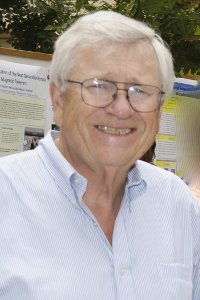Putting photochemistry to work. Nanomaterial strategies for uncaging small molecule bioregulators

Peter C. Ford, PhD
Distinguished Professor of Chemistry
Department of Chemistry and Biochemistry
UC Santa Barbara
Biography
Prof. Ford joined the UCSB faculty after graduate study with Kenneth B. Wiberg at Yale and a postdoctoral fellowship with Henry Taube at Stanford. He has been a Visiting Fellow at the Australian National U, Guest Professor at U Copenhagen, A v Humboldt Foundation Fellow at U Regensberg and U Muenster and Guest Investigator at the US National Cancer Institute. Prof. Ford's Honors include the 1992 Richard C. Tolman Medal of the So. Calif Section of the American Chemical Society, a A v Humboldt Senior US Scientist Award (1992), the 2008 Inter-American Photochemical Society Award in Photochemistry, the 2013 ACS National Award for Distinguished Service to Inorganic Chemistry and the 2015 Royal Society of Chemistry Inorganic Mechanisms Award. His current research focuses on photochemical delivery of bioactive small molecules to physiological targets and on catalytic biomass conversion to chemicals and fuels.
Abstract
This talk will summarize ongoing studies in our laboratory that aim to develop effective methodologies for the photochemical delivery of the bioregulatory molecule nitric oxide as well as other bioactive small molecules such as carbon monoxide to physiological targets. While a number of compounds can serve as photochemical precursors of NO and CO, most are not photoactive in the wavelength ranges (longer visible and NIR) capable of deep tissue penetration. Thus, our current focus is on developing conjugate systems incorporating antennas designed to utilize tissue-penetrating red or near infrared light as the excitation source. In this context, we are exploring various nanomaterials that can serve as NIR antennas including lanthanide based upconverting nanoparticles. A second focus is on designing pathways to deliver these conjugates to specific sites. This concern has led us to explore polymer based micro- and nano-carriers that can be modified to take advantage of biological mechanisms that allow one to target particular cell or tissue types.


